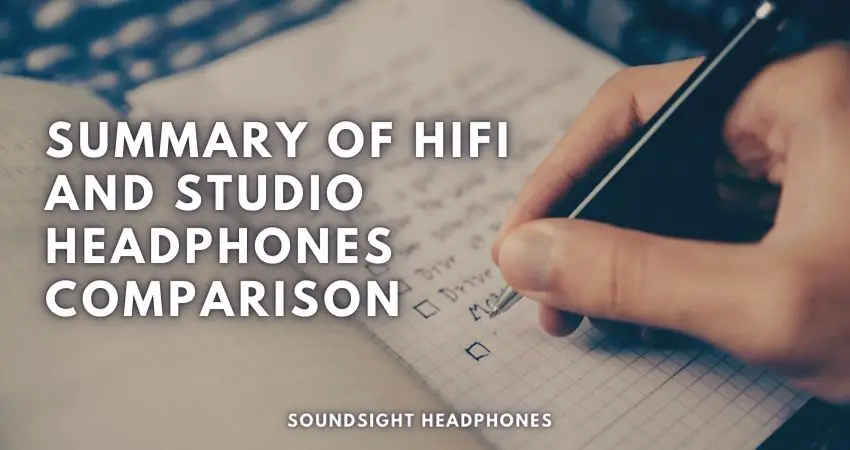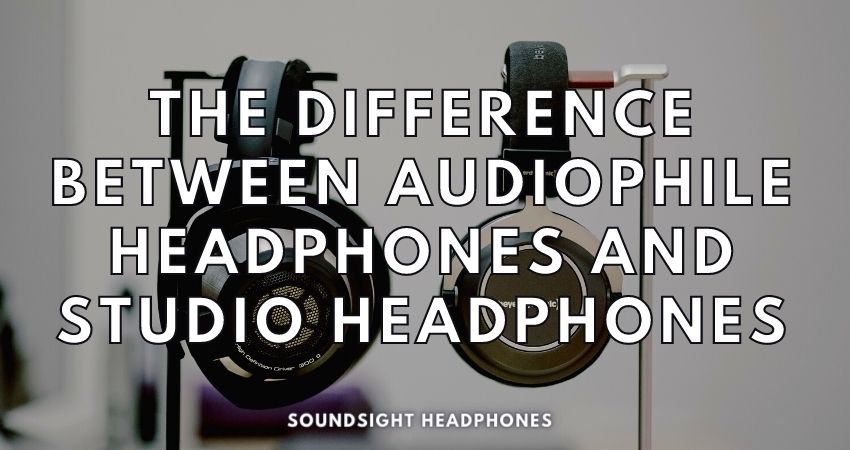Audiophile headphones or high-fidelity headphones embody some similarities to studio headphones, which often creates confusion. But how do they differ? Is there a difference at all? The two should not be considered interchangeable. Some important aspects used to differentiate the two types of headphones include the purpose of use, sound signature, pricing, comfort, portability, and durability.
This article highlights the differences between audiophiles and studio headphones. While both headphone types are great for listening to music, each has different characteristics, making them unique for various purposes.
Audiophile and studio headphones – understanding the basics
What are audiophile headphones?
Audiophile headphones are medium to high-priced headphones driven by high-end components that pair well with an amplifier/DAC with high-fidelity audio reproduction capabilities. They typically lack microphones or playback controls, wireless connectivity, or other technologies that compromise the fidelity of sound reproduction.
What are studio headphones?
Studio headphones are neutral-sounding headphones explicitly designed to provide accurate sound reproduction with good detail and no loss of auditory information.
They have minimal imperfections in the sound and are designed to be used in a recording studio for professional purposes, enabling the nuances of the recording to be heard more easily.
Finally, studio headphones are inexpensive and can be used for various purposes besides studio work.
The differences between audiophile headphones and studio headphones
The label “audiophile headphones” has become a marketing buzzphrase, and the same goes for the term “studio headphones.” It’s wise to know that there are some apparent differences between studio headphones and audiophile headphones, which I will elaborate on. However, as one user on Head-fi.org stated:
Studio monitor focuses on real sound reproduction. Midrange comes first, then treble, then bass. It has to be flat, then the producer/mixer takes that and does whatever he wants with it. It doesn’t color the sound. You have to have isolation, so you only hear the sound coming from the studio monitors. Audiophile headphones, on the other hand, take all that and emphasize. They make it more fun rather than flat. It uses unnecessary higher-grade materials. I own MDR-R10 and MDR-7506. I am a sound engineer.
Audio-Fi
Professional use vs. home use
The main difference between high-fidelity headphones and professional studio headphones is the way they are used and what they do best.
- Studio headphones are designed for studio recording, mixing, and mastering. You can seldom use them for DJing, but their sound isolation and flat, detailed, accurate sound response are most important for producing music. Therefore, most studio headphones come in different categories for different applications. Closed-back headphones for monitoring, voice and instrument recording, and tracking; open-back headphones for mixing and mastering. Lightweight on-ear headphones with swiveling ear cups for DJing.
- Audiophile headphones are designed for high-fidelity melodic sound reproduction, listening, and music appreciation. Sound fidelity is the most crucial criterion, and they are often used as an alternative to studio headphones for home use. In contrast to studio headphones, which can sound dull even when reproduced with precision and detail, audiophile headphones cannot be used to produce music, but they do not interfere with the enjoyment of listening to music either.
In the end, studio headphones are an indispensable tool for professional producers and music engineers. Their flat sound reproduction is essential to achieving accurate and unaltered sound when recording music. On the other hand, audiophile headphones are unsuitable for professional music production, but they are excellent headphones for home use, with attractive and engaging sound performance.
Sound signature
Both audiophile and studio headphones differ in their sound quality, but the most important difference lies in the sound signature of each. Studio headphones are designed for flat, accurate, and uncolored reproduction, with accurate frequency response.
On the other hand, audiophile headphones are designed for sound reproduction, listening, and music appreciation. The fidelity of their sound is the most important here, and they are often used as alternatives to studio headphones.
Audiophile headphones don’t have the same isolation or sound linearity necessary for music production as studio headphones. However, audiophile headphones do not take away the pleasure of listening to music.
A distinct difference between audiophile headphones and studio headphones, is that some audiophile headphones use a specific type of speaker driver known as planar magnetic to produce a more accurate sound than dynamic drivers.
Planar magnetic headphones have a flat frequency response, which is important to hi-fi enthusiasts because they produce accurate sound across all frequencies. However, due to the fragility and size of their transducers, they are often less reliable than their dynamic counterparts.
Studio headphones use dynamic drivers, which are more durable and have the ability to play with less power than planar magnetic headphones.
Value and reliability
Professionals and experts alike know that studio headphones must be reliable and expendable. These headphones can cost upwards of $500, but budget studio headphones work very well, and their sound presentation is designed for professional sound engineers who often need to hear exactly what a mix sounds like before it’s finalized.
Studio headphones are cheaper and more affordable than audiophile headphones. They are designed to help you produce music rather than enhance the music you love. Most studio headphones are not overly concerned with styling and premium materials but rather focus on durability, comfort, and value.
Unless you buy affordable entry-level hi-fi headphones, even if they are reliable, it doesn’t make sense financially to use them as a sound recording and mixing tool. Audiophile headphones are more expensive and sometimes heavier and harder to handle in the studio than headphones designed for studio use.
Portability and sound isolation
Audiophile headphones are designed to be used at home, so they don’t have portability features like foldable ear cups or a comfortable, lightweight design. Instead, they are a pair of stationary headphones with their own character with an exquisite look.
Hifiman HE-400, Audio-Technica ATH-W1000Z, and Meze 99 Classics are great examples of audiophile headphones with aesthetic appearance.
Studio headphones are more portable and make sense to carry you to different places. They are lighter, and you can fold the ear cups for better storage and transportation. Additionally, due to the way studio headphones are constructed, they offer above-average sound isolation, which is crucial for recording music.

Summary of the differences between audiophile headphones and studio headphones
- Audiophile headphones are distinguished from studio headphones by their sound signature. Although their sound is advertised as “high fidelity”, which means that they reproduce sound with great fidelity to the original, audiophile headphones have a sound signature that is not so flat. It’s not too colorful either, but they can afford a colorful sound profile, unlike studio headphones.
- Studio headphones are designed with flat, neutral, or balanced sound reproduction in mind and therefore have a much duller sound signature than audiophile headphones. The soundstage is average, but imaging is good and sound reproduction is always accurate. There is, therefore, no difficulty in listening to the recording.
- Studio headphones are intended for professional use, and their performance is most important when recording. The main criteria are good sound isolation, comfort quality, and detailed and revealing frequency response.
- Studio headphones are designed for extended use, often 8 hours a day. Audiophile headphones have a heavier, more robust structure that allows for shorter listening sessions, but their construction is generally very durable and gives them an artistic character.
- Audiophile headphones are designed to be used at home in a dedicated listening room. They are not intended to be used on the move because they are heavy and not portable. Studio headphones are portable and often have several detachable cables, one of which is 2 to 3 meters long, allowing them to be used in a variety of situations.
- All audiophile headphone models have one thing in common: they look impressive and cool. Studio headphones are simple and have a clean, minimalist design with no intricacies.
Similarities between studio headphones & hi-fi headphones
Some studio headphones can be used as hi-fi headphones and vice versa; however, the union of these two types of headphones is rare, so it is not useful to elaborate on this point, thus this section only summarizes the similarities between them.
The first similarity between studio headphones and hi-fi headphones is their function: listening to music. However, there are more specific elements to consider:
- Studio headphones can be connected directly to a microphone, audio interface, or mixer using a 1/4” jack or adapter. Audiophile headphones can be equipped with balanced cables, which are excellent for studio use because they reduce noise generated by electrical interference, thus ensuring high-fidelity sound.
- Both types of headphones are often made of sturdy materials: durable plastic, metal, or aluminum, and stainless steel.
- Neither type of headphone has microphones nor control buttons.
- Both types of headphones have a detailed, low-distortion sound and offer a wide range of frequency responses with good stereophonic and spatial qualities.
FAQ
Can audiophile headphones be used as studio headphones?
Audiophile headphones are slightly more colored versions of studio headphones, and while they are viable for studio applications, they’re not the best option. Studio headphones are designed specifically for studio use, and audiophile headphones are usually designed for high-fidelity listening, not professional activities.
Which is better, audiophile or studio headphones?
Both are great options for listening to music, but the deciding factor in determining which headphones are best should be based on the purpose of the headphones and your listening preference. If you want to use headphones for playing, streaming, or just like to be immersed in the details of your music, studio headphones are the ideal choice. However, if you want to listen to music and feel the emotion of the music you love, then audiophile headphones will suit your needs better.
Conclusion
The labels “high-fidelity headphones” and “studio headphones” have confused many people. There are obvious differences between studio headphones and audiophile headphones, but once you know the basics of both products, you’ll find that while they are unique, yet share some similarities.
A slight overlap exists between audiophile and studio headphones, so you can have a versatile pair of headphones for both applications. Nevertheless, you shouldn’t try to cut corners by using audiophiles or studio headphones that aren’t specifically designed for their intended use.
On that note, here are some important things you need to know about audiophile and studio headphones. If you’re in the market for a pair of audiophile or studio headphones, I can help. LINK HERE
